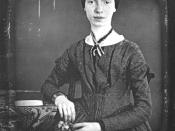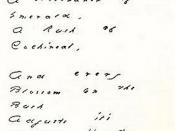Light after the Dark
Two Poems. Two Ideas. One Author. Two of Emily Dickinson's poems, "Because I Could Not Stop For Death"(940-941)and "I Heard A Fly Buzz-When I Died ,"(941-942) are both about one of life's few certainties: death. However, that is where the similarities end. Although both poems were created less than a year apart by the same poet, their ideas about what lies after death differ. In one, there appears to be life after death, but in the other there is nothing.
In the piece, "Because I Could Not Stop For Death," we are being told the tale of a person who is being taken away by Death. This is our first indication that this poem believes in an afterlife. In most religions, where there is a grim reaper like specter, this entity will deliver a person's soul to another place, usually a heaven or a hell.
In this case, it does not state which.
In the second stanza, "We drove slowly- He knew no haste," (li 5)it shows that they were traveling to an after life very slowly because death had finally come and the person is peacefully giving in. Might as well be calm and relaxed.
In the fifth stanza, Death and the woman pause before "...a House that seemed A Swelling of the Ground- The Roof was scarcely visible- The Cornice in the Ground-"(17-20) though the poem does not directly say it, it is highly probable that this grave is the person's own. It is also possible the person's body already rests beneath the soil in a casket. If this is at all accurate, then their spirit or soul may be the one who is looking at the "house." Spirits and souls usually mean there is an afterlife involved.
It isn't until the sixth and final stanza where the audience obtains conclusive evidence that "Because I Could Not Stop For Death" believes in an afterlife. The woman recalls how it has been "...Centuries- and yet feels shorter than the Day I first surmised the Horses' Heads were toward Eternity- "(li 21-24) . To the woman, it has been a few hundred years since Death visited her, but to her, it has felt like less than a twenty-four hours. Since the body cannot live on for hundreds of years, then it must be none other then the soul who has come to the realization that so much time has passed. The final part with the horses refers to the horse drawn carriage the woman was riding in when she passed away. In those two final lines, the horses seem to be leading her into Eternity, possibly into an afterlife.
It is just the exact opposite is Dickinson's other poem, "I Heard A Fly Buzz-When I Died," With this particular piece of literature, the clues which point to the disbelief in an afterlife are fewer and not as blatant, but are all still present. In this poem, a woman is lying in bed with her family standing all around waiting for her eventual death.
While the family is waiting for her to pass on, she herself is waiting for "...the King..." (li 7). No, we're not talking about Elvis, but instead this King is some sort of omnipotent being, a god. Later as the woman dies, her eyes (or windows as they are referred to in the poem) fail, then she "...could not see to see-" (li 16). When she says this, what she seems to mean is she could not see any of the afterlife or Kings she expected to be there. The woman's soul drifted off into nothingness with no afterlife to travel to.
To conclude, the beliefs of the two Dickinson poems in regards to life after death differ significantly. In one, "Because I Could not Stop for Death," the afterlife does exist, in the other, "I Heard a Fly Buzz- When I Died," it does not. It seems that Dickinson, too, questioned the question of whether or not there is an afterlife, and she herself, being so in touch with death, could not come to a solid conclusion. There is only one way to tell.



Very well done
This is a very good essay. The author analyzed two poems, two ideas, one author thoroughly and made very nice beginning and conclusion portion. The question whether there is afterlife is also very concerned by a lot of people and so many people still hesitate it. Very good work,I will mark it well done, thanks.
8 out of 8 people found this comment useful.